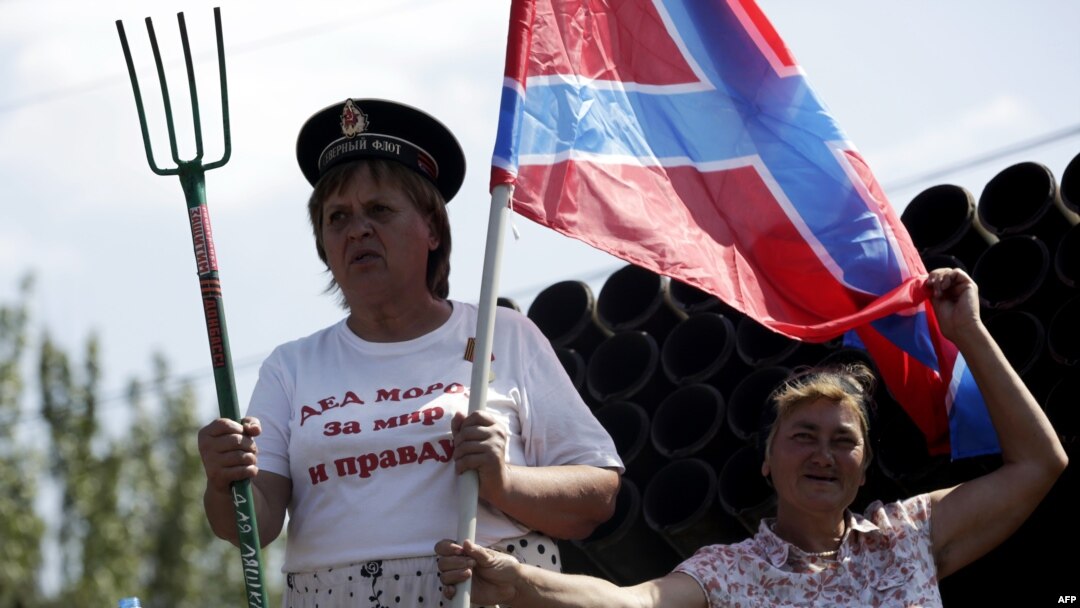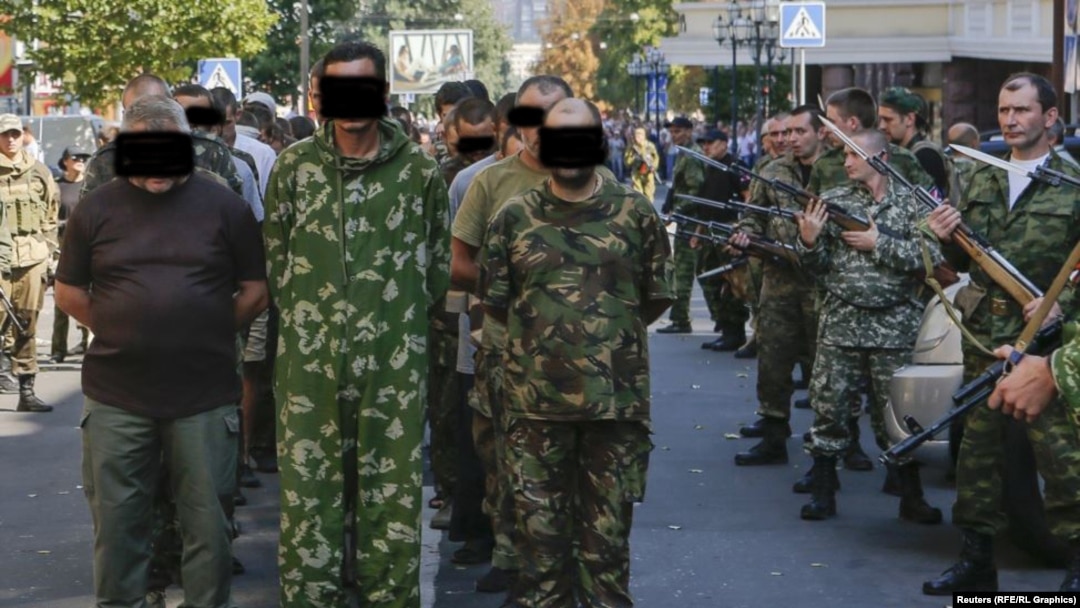When pro-Russian separatists marched captured Ukrainian soldiers at bayonet-point through the streets of Donetsk over the weekend, the crowd jeered, cursed, and hurled refuse at the haggard prisoners.
It was a spectacle that shocked many, including human rights activists who called the procession a clear violation of the Geneva Conventions' rules on the treatment of prisoners of war (POWs). But whether the forced march constituted a war crime -- and whether it could be prosecuted as such -- is not so clear-cut, international law experts say.
This ambiguity lies largely in how the Ukraine conflict itself is classified, according to David Glazier, an international law expert at Loyola Law School in Los Angeles.
The rules for civil wars spelled out in the conventions ban "outrages upon personal dignity" and "humiliating and degrading treatment" of POWs. The rules for wars between governments set a lower bar by including a ban on subjecting these prisoners to "insults and public curiosity," both of which were on prominent display at the August 24 parade in Donetsk.
"If this is an international armed conflict, this definitely seems to be a clear...violation of the Geneva Convention language," Glazier says of the POW march. "The problem is if it's not an international armed conflict, then the standard is a much harder one to satisfy: the actual 'outrage upon personal dignity.' And it's not clear that this rises to that level."
The International Committee of the Red Cross, the guardian of the Geneva Conventions, has called the war in Ukraine a "noninternational armed conflict." Kyiv and Western governments, meanwhile, have accused Russia of providing arms and other support to the rebels in eastern Ukraine -- accusations Moscow denies.

A woman rides on the back of a truck holding a pitchfork and a flag of Novorossia (Newrussia, a union between the "Donetsk People's Republic and "Lugansk People's Republic") in the parade on August 24 in Donetsk.
Even if the conflict were to be classified as a war between Ukraine and Russia -- bringing the "public curiosity" language into play -- "all war crimes are not created equal," says law of war expert Michael Scharf, the interim dean at Case Western Reserve University School of Law.
The "public curiosity" provision is not among the "grave breaches" of the Geneva Conventions, which include crimes such as "willful killing" and "torture and inhumane treatment," he noted. "So while this is certainly something that would be of concern, I don't think this is the kind of thing that you could bring Russia, for example, to the International Criminal Court and have a whole case based on," Scharf says of the POW parade.
Neither Russia nor Ukraine -- nor the United States -- is a signatory to the International Criminal Court (ICC), though Kyiv has accepted the Netherlands-based court's jurisdiction for crimes committed on Ukrainian territory between November 21, 2013, and February 22, 2014. Ukraine would have to submit another declaration or an amendment to bring more recent events -- such as the Donetsk parade -- within the ICC's jurisdiction, Scharf notes.
Rights activists denounced the prisoner march as an unequivocal violation of the Geneva Conventions. The parade clearly meets the threshold of "humiliating and degrading treatment" under Article 3 of the Geneva Conventions, Human Rights Watch deputy director Rachel Denber said on Twitter.
Her comment was echoed by Tanya Lokshina of HRW's Moscow office. "The so-called parade of prisoners in Donetsk today is not only revolting from a purely human perspective, but it is a clear violation of international humanitarian law," Lokshina told RFE/RL.
Nazi, Soviet Parades
There is a precedent for successful prosecution of individuals for parading prisoners of war before the public.
In September 1946, a U.S. military commission convicted German Lieutenant General Kurt Maezler of "exposing" several hundred U.S. and British POWs in his custody "to acts of violence, insults, and public curiosity" by ordering them to be paraded through the streets of Rome in January 1944.
Onlookers hurled sticks and stones at the POWs, the prosecution alleged, though Maezler's defense argued that they threw flowers and cigarettes. Photographs of the parade appeared in the Italian press accompanied by the caption: "Anglo-Americans enter Rome after all...flanked by German bayonets," according to a 1949 report commissioned by the United Nations.
The ban on exposing POWs to such public forums is not aimed at protecting them from moral injury, but from physical harm as well, Scharf says. During World War II, there were several instances of POWs killed after being stoned or beaten by crowds at such parades. "There were a couple of high-profile prosecutions for that in the Nuremberg Tribunal era," he explains. "So this is not just about the public curiosity through images, but also the protection of the individuals whose lives are at risk when they're being paraded."
The parade in Donetsk echoed the 1944 parade in which the Soviet government marched thousands of German POWs through the streets of Moscow, also at bayonet-point. Large trucks then sprayed the streets with water in a symbolic cleaning of the roads after the German soldiers.
Street-cleaning trucks were deployed in similar fashion at the Donetsk parade over the weekend. Three of the bulky vehicles drove slowly and rinsed the roads about 60 meters behind the procession.
The symbolism was not lost on one spectator filming the parade. "Bravo," he said enthusiastically. "That's telling. They're cleaning the streets after them."


